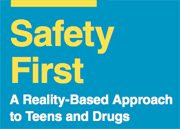 A very worthwhile booklet published by the Drug Policy Alliance helps parents evaluate and discuss strategies for protecting their teenagers from drug abuse. Since the original publication of Safety First: A Reality-Based Approach to Teens and Drugs, more than 300,000 copies have been distributed worldwide.
A very worthwhile booklet published by the Drug Policy Alliance helps parents evaluate and discuss strategies for protecting their teenagers from drug abuse. Since the original publication of Safety First: A Reality-Based Approach to Teens and Drugs, more than 300,000 copies have been distributed worldwide.
Author Marsha Rosenbaum* is director emerita of the San Francisco office of the Drug Policy Alliance, where she spearheaded DPA’s work on youth and drugs and created the Safety First booklet; it is available (free) online in multiple languages. The following is a selection from the booklet.
Americans have been trying to prevent teenage drug use for more than a century – from the nineteenth- century Temperance campaigns against alcohol to Nancy Reagan’s “Just Say No.” A variety of methods, from scare tactics to resistance techniques to zero-tolerance policies and random drug testing (not to mention more than 750,000 arrests in 2009 for marijuana possession alone), have been used to try to persuade, coax and force young people to abstain.
The effectiveness of these conventional approaches, however, has been compromised by:
- the unwillingness to distinguish between drug use and abuse by proclaiming “all use is abuse”;
- the use of misinformation as a scare tactic; and
- the failure to provide comprehensive information that would help users to reduce the harms that can result from drug use.
Few things are more frightening to a parent than a teenager whose use of alcohol and/or other drugs gets out of hand. Surveys tell us that despite our admonitions and advice to abstain, large numbers of teenagers will occasionally experiment with intoxicating substances, and some will use alcohol and/or other drugs more regularly. This does not mean they are bad kids or we are neglectful parents. The reality is that drug use is a part of teenage culture in America today. In all likelihood, our young people will come out of this phase unharmed; virtually all studies have found that the vast majority of students who try legal and/or illegal drugs do not become drug abusers.
The vast majority of teenage drug use (with the exception of nicotine) does not lead to dependence or abusive habits. In fact, in our workshops with students, they consistently request the “real” facts about drugs so they can make responsible decisions – and the vast majority actually do. According to the 2009 National Survey on Drug Use and Health, although experimentation is widespread, 90 percent of 12- to 17-year-olds choose to refrain from regular use.
Keeping teenagers safe should be our highest priority. To protect them, a reality-based approach enables teenagers to make responsible decisions by:
Providing honest, science-based information:
Effective drug education should be based on sound science and acknowledge teenagers’ ability to understand, analyze and evaluate. The subject of drugs can be integrated into a variety of high school courses and curricula, including physiology and biology (how drugs affect the body), psychology (how drugs affect the mind), chemistry (what’s contained in drugs), social studies (who uses which drugs, and why) and history and civics (how drugs have been handled by various governments).
Encouraging moderation if youthful experimentation persists:
Teens who do use alcohol, marijuana and/or other drugs must understand there is a huge difference between use and abuse, and between occasional and daily use. They should know how to recognize irresponsible behavior when it comes to place, time, dose levels and frequency of use.
If young people continue, despite our admonitions, to use alcohol and/or other drugs, they must control their use by practicing moderation and limiting use. It is impossible to do well academically or meet one’s responsibilities at work while intoxicated. It is never appropriate to use alcohol and/or other drugs at school, at work, while participating in sports, while driving or engaging in any serious activity.
Promoting an understanding of the legal and social consequences of drug use:
Young people must understand the consequences of violating school rules and local and state laws against the use, possession and sale of alcohol and other drugs – whether or not they agree with such policies. Young people need to know that if they are caught in possession of drugs, they will find themselves at the mercy of the juvenile and criminal justice systems.
There are real, lasting consequences of using drugs and being caught, including expulsion from school, a criminal record and social stigma. The Higher Education Act – now being challenged by many organizations, including Students for Sensible Drug Policy (www.ssdp.org) – has resulted in the denial of college loans for more than 200,000 U.S. students convicted of any drug offense. This law was scaled back in 2006, but the penalty still applies to students who are convicted while they are enrolled in school.
Prioritizing safety through personal responsibility and knowledge:
The vast majority of teenage drug use (with the exception of nicotine) does not lead to dependence or abusive habits. In fact, in our workshops with students, they consistently request the “real” facts about drugs so they can make responsible decisions – and the vast majority actually do. According to the 2009 National Survey on Drug Use and Health, although experimentation is widespread, 90 percent of 12- to 17-year-olds choose to refrain from regular use.
See Part 2: Teens & Drugs: What’s a Parent to Do?
* * *
* From 1977 to 1995, Rosenbaum was the principal investigator on National Institute on Drug Abuse-funded studies of heroin addiction, methadone maintenance treatment, MDMA (Ecstasy), cocaine, and drug use during pregnancy.